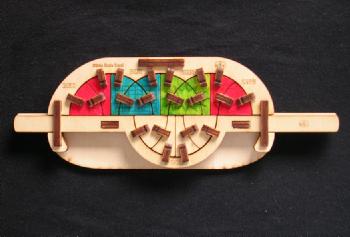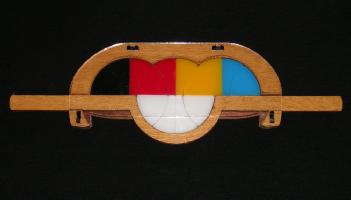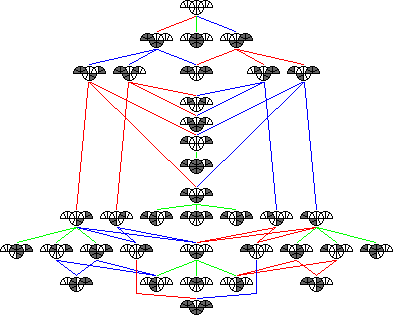



This puzzle has moving pieces which in the top half of the frame form
three overlapping semicircles, and in the bottom half only one semicircle. The bottom
half can slide left and right so that its semicircle can line up with any of the three
of the top half. In the solved position every quarter circle has 2 pieces. One piece
in the shape of the overlapping area of semicircles, namely like a triangle with a
flat base and two convex curved sides. The other piece is a thin vertical quadrangle,
shaped a bit like the head of an axe. This latter piece comes in two types, mirror
images of each other.
The puzzle is mixed up by lining up the lower semicircle with one of the upper ones
to form a circle, and then rotating it a quarter or a half turn. Note that when quarter
turns are used, some of the axe pieces will lie horizontal, and may block another circle
from turning. The pieces of the top half are coloured, so that they have unique solved
positions.
These puzzles were invented by Douglas A. Engel, who also invented various other puzzles such as:
There are two versions of this puzzle, both shown in the pictures above. The first is completely made of wood, and simply called the Slide Rule Duel. Douglas later used a different design, with plastic pieces and a transparent plastic front cover. He also made several other slide rule puzzles, so this puzzle got the more specific name "Binary Bisect 5".
If you disregard the colours of the pieces, there are 36 possible
configurations they can form. There is no easy way to see this, I simply
counted them (or actually let my computer count them).
There are 8 axe pieces, 4 of each type. Given some configuration,
any permutation of them is possible. This gives rise to 4!·4!
possibilities.
There are 6 triangular pieces. It turns out that there are only 60 permutations
that these can achieve instead of the 6!=720 that you might expect. It is tricky
to show why this is the case, and I haven't been able to prove it. It is similar
to what happens in the Bandaged Cube, however.
Putting all this together we get 36·60·4!·4! = 1,244,160 positions.
I have used a computer to calculate God's algorithm, and the results in the table below show that any position can be solved in at most 17 turns (13.156 on average), or 22 quarter turns (16.470 on average). These results were independently verified by Oriel Maxime.
| Face turn metric | ||||||||||||||||||||
|---|---|---|---|---|---|---|---|---|---|---|---|---|---|---|---|---|---|---|---|---|
| Q u a r t e r t u r n m e t r i c |
0 | 1 | 2 | 3 | 4 | 5 | 6 | 7 | 8 | 9 | 10 | 11 | 12 | 13 | 14 | 15 | 16 | 17 | Total | |
| 0: | 1 | 1 | ||||||||||||||||||
| 1: | 6 | 6 | ||||||||||||||||||
| 2: | 3 | 8 | 11 | |||||||||||||||||
| 3: | 16 | 14 | 30 | |||||||||||||||||
| 4: | 6 | 32 | 30 | 68 | ||||||||||||||||
| 5: | 30 | 51 | 27 | 108 | ||||||||||||||||
| 6: | 11 | 46 | 103 | 44 | 204 | |||||||||||||||
| 7: | 52 | 96 | 142 | 56 | 346 | |||||||||||||||
| 8: | 18 | 87 | 259 | 334 | 152 | 850 | ||||||||||||||
| 9: | 86 | 201 | 515 | 746 | 344 | 1,892 | ||||||||||||||
| 10: | 29 | 149 | 564 | 1,478 | 1,665 | 710 | 4,595 | |||||||||||||
| 11: | 136 | 353 | 1,318 | 3,518 | 3,298 | 1,134 | 9,757 | |||||||||||||
| 12: | 46 | 218 | 1,002 | 4,201 | 8,007 | 5,855 | 1,536 | 20,865 | ||||||||||||
| 13: | 214 | 553 | 2,679 | 10,454 | 15,404 | 9,940 | 2,362 | 41,606 | ||||||||||||
| 14: | 73 | 362 | 1,657 | 9,120 | 25,188 | 30,016 | 16,025 | 2,530 | 84,971 | |||||||||||
| 15: | 336 | 923 | 4,930 | 23,586 | 50,451 | 50,994 | 21,456 | 1,973 | 154,649 | |||||||||||
| 16: | 112 | 551 | 2,565 | 15,410 | 54,660 | 92,991 | 65,672 | 13,025 | 402 | 245,388 | ||||||||||
| 17: | 430 | 1,275 | 6,202 | 33,358 | 91,324 | 114,686 | 48,913 | 3,800 | 14 | 300,002 | ||||||||||
| 18: | 115 | 506 | 2,021 | 12,674 | 51,991 | 98,208 | 65,819 | 9,771 | 229 | 241,334 | ||||||||||
| 19: | 194 | 476 | 2,030 | 12,744 | 37,598 | 45,461 | 13,158 | 300 | 111,961 | |||||||||||
| 20: | 6 | 23 | 123 | 1,247 | 5,689 | 10,222 | 5,922 | 516 | 23,748 | |||||||||||
| 21: | 1 | 21 | 195 | 561 | 793 | 152 | 1,723 | |||||||||||||
| 22: | 4 | 21 | 20 | 45 | ||||||||||||||||
| Total: | 1 | 9 | 30 | 87 | 197 | 428 | 977 | 2,327 | 6,059 | 16,083 | 41,065 | 95,299 | 194,789 | 319,699 | 346,034 | 185,978 | 33,867 | 1,231 | 1,244,160 | |
Let a clockwise quarter turn the left, middle, and right disks be denoted by the letters L, M, R respectively. Half turns will be denoted by L2, M2, and R2. Finally, anti-clockwise quarter turns will be L', M' , and R'.

Phase 1: Get the correct configuration.
Phase 2: Solve the axe pieces.
Phase 3: Solve the triangle pieces.